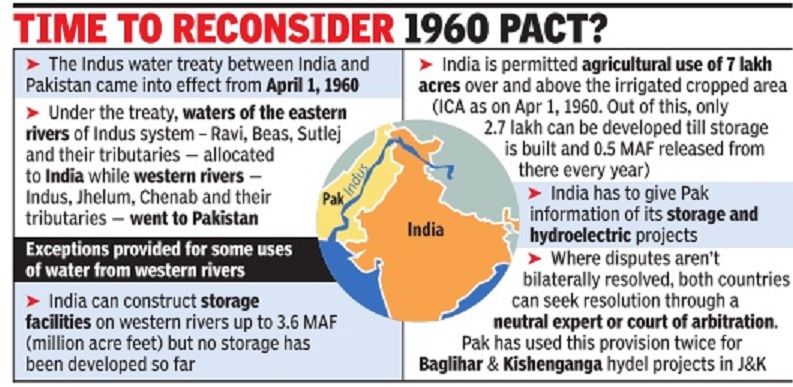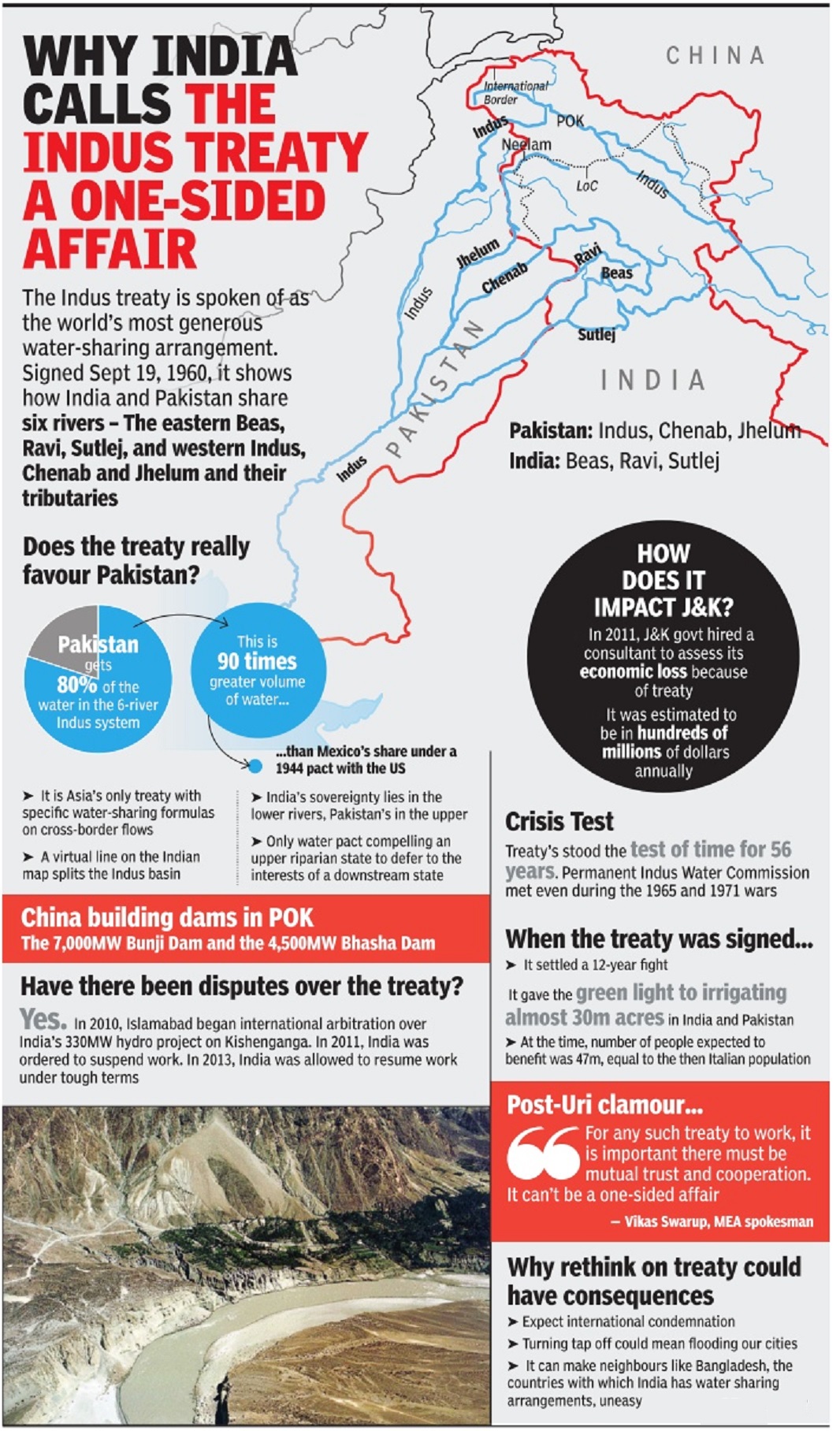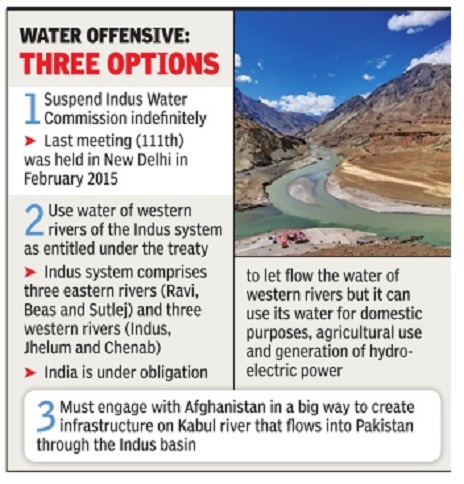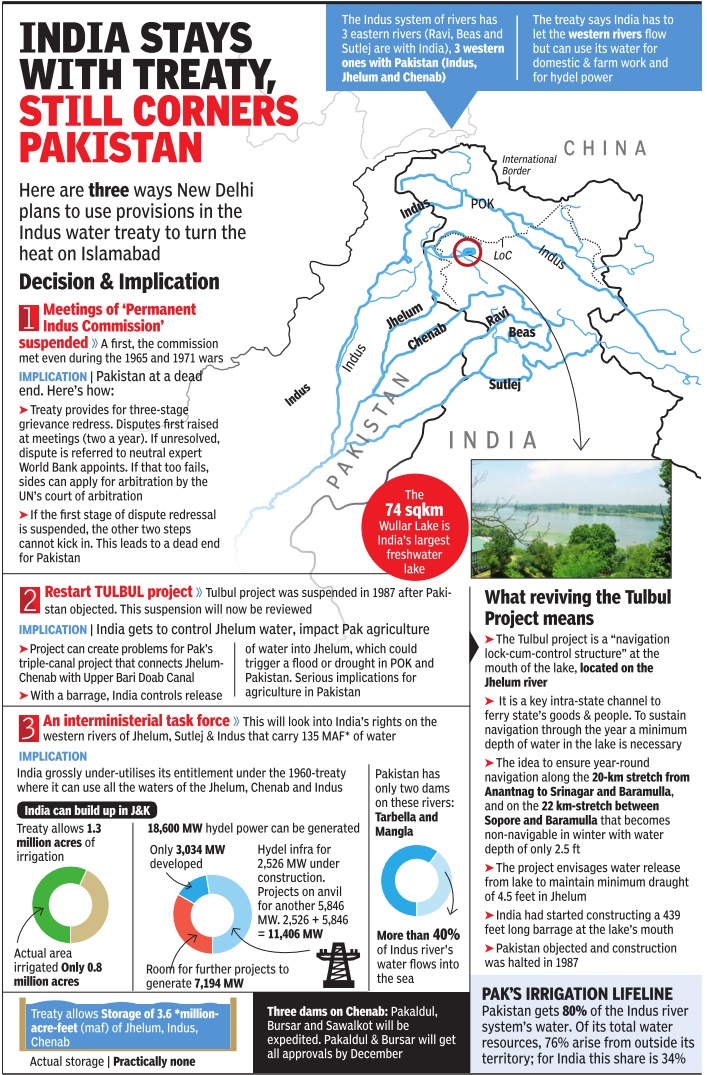Indus Water Treaty
This is a collection of articles archived for the excellence of their content. |

The Times of India
Contents |
The treaty
Nehru “purchased peace with the treaty“
Indus pact once a peace gesture, Sep 27 2016 : The Times of India
The Indus Water Treaty was once seen by India as a gesture of peace. The treaty was, in fact, believed to be an incredibly generous gesture by an upper riparian state for a lower riparian one.
Former PM Jawaharlal Nehru had even acknowledged it in Parliament and observed that India had, in fact, “purchased peace with the treaty“. The planned action against Pakistan will likely win favour from Jammu & Kashmir, which has believed for years that it had got a raw deal on the water-sharing arrangement.
In 2003, an all-party resolution in the J&K assembly had basically asked the Centre to walk out of the treaty . As per the decisions taken on Monday , India now wants to fully utilise what is due to it for agriculture, storage and hydropower.
Currently , India stores no water from the western rivers, but is permitted to store 3.6 million acre feet (MAF).That, the government says, will now be done, directly impacting the amount of water available to Pakistan.
One-sided, against India
India’s options vis-à-vis Pakistan

The Times of India

The Times of India

The Times of India
Amid clamour for a rethink on the Indus Waters Treaty with Pakistan in the wake of the Uri terror strike, experts have argued that short of the “extreme“ step of abrogation, India has other options like use of water of western rivers of the Indus system or suspension of the meetings of Indus Water Commission to put pressure on its neighbour.
The experts point out that these available options would be enough to send signal to Pakistan about the leverage India has over the entire river system without actually scrapping the treaty or violating any of its clauses.
“Abrogation of treaty is neither practical nor desirable. India can rather go for the extreme option of suspending the meeting of the Commission. However, the more realistic option would be to use water of the western rivers of the Indus system, which is well within the framework of the treaty ,“ said Uttam Sinha of the Institute of Defence Studies and Analyses (IDSA).
Under the Indus Water Treaty , signed between the two countries in 1960, water of eastern rivers (Ravi, Beas and Sutlej) are allocated to India while the country is under obligation to let flow the water of the western rivers (Indus, Jhelum and Chenab) to Pakistan.
India can, however, use the water from the western rivers for its domestic purposes, irrigation and generating hydro-electric power.
“We should use this option legitimately . It is India's right under the treaty . Pakistan cannot challenge this as it knows that India can use water of western rivers under the specified clauses of the treaty. If India exercises this option, it would be enough to put Pakistan under extreme pressure,“ Sinha told TOI on Friday .
River expert and environmentalist Himanshu Thakkar of the South Asia Network on Dams, Rivers and People (SANDRP) agrees with such an option. India has been permitted to construct storage of water on western rivers up to 3.6 million acre feet (MAF) for various purposes, but the country has, so far, not developed any storage facility .
Thakkar said, “We have never exercised our rights under the treaty as we have not created infrastructure on our side to use water of western rivers. We must, therefore, concentrate on building barrages and other storage facilities to use the water.“
Thakkar too found the idea of abrogating the treaty impractical. He said, “It will not solve any purpose. It won't help India militarily . It will, instead, damage India's credibility at international forums. We have treaties and water-sharing arrangements with other neighbours like Nepal, Bhutan, Bangladesh and China. Abrogation of treaty will certainly not send the right signal.“
The experts also pointed at the third option where India can align itself with Afghanistan by helping it create infrastructure on the Kabil river that flows into Pakistan through the Indus basin.
Sinha said, “Though India has been engaged with Afghanistan, there is a need to go for it in a big way in our strategic interest. This option will also exert pressure on Pakistan.“
India has set in motion its ambitious plan to utilise its share of water from western tributaries of the Indus, a decision driven by India-Pakistan geopolitics, which may see work begin on a major hydel project on the Chenab early next year. It is a long haul to implement PM Narendra Modi's September 27 decision to review water use within the ambit of the Indus Water Treaty (IWT) with Pakistan, but the government has prioritised three hydel projects on Chenab and its tributary --Sawalkot (1,856 MW), Pakal Dul (1,000 MW) and Bursar (800 MW) --in a time-bound manner.
Building infrastructure on Indus, Chenab, Jhelum and their tributaries is a huge task but the short-listed projects are intended to express India's political will and preparedness to respond to Pakistan's use of terrorism against India with every option at its command including a new preparedness to use all possible leverage points.
“The Centre has constantly been in touch with Jammu & Kashmir government for all necessary ground work. Execution of Sa walkot project is expected to start early next year. The under-construction Pakal Dul project has already received an impetus after the government displayed an urgency to complete it on time,“ said an official.
The Sawalkot project envisages a 193-meter-high dam on Chenab for generating 1,856 MW. It will be constructed in two phases. Since 629 families consisting of 4,400 individuals are likely to be displaced, the state government has been working on a proper rehabilitation plan before actual work begins.
The Bursar project will, however, take time before it gets clearances. “Since had initially termed it an unviable project on certain grounds, there is need for proper study before the government goes ahead with it. The project may be tweaked to make it viable as it is now our priority area,“ said the official.
As previous cost and viability calculations are revised in view of the political imperative, India could be looking to use as much of Indus water as it can. “Maximising use of water must be priority. It is good that the government has sincerely moved to execute pending pro jects to legitimately use its share of water within IWT.This is the most realistic option well within the framework of the treaty,“ said Uttam Sinha of the Institute of Defence Studies and Analyses (IDSA).
Towards this end, speeding up pending hydro-power projects is only one component of what India can do to utilise its share of water under the IWT. Under the 1960 treaty, India is permitted to construct storage capacities on the western rivers up to 3.6 million acre feet (MAF) for various purpo se including domestic use.India has, so far, not developed any storage facility or tapped its full quota of water for irrigation.
Referring to the World Bank's recent decision to set up a Court of Arbitration (CoA) to settle disputes relating to Kishanganga and Ratle hydro projects on Pakistan's demand, Sinha said India should forcefully tell the Bank to factor in technological changes and new knowledge while looking at the implementation of ongoing projects.